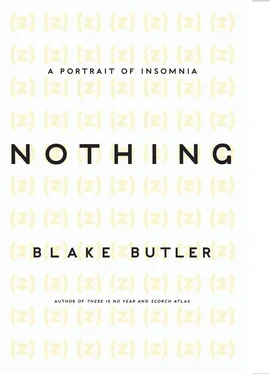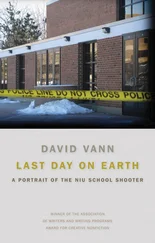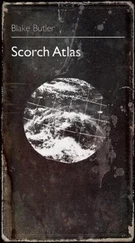Several instances involving the acquittal of pending rape charges provide the same reasoning as in the cases of homicide: that the sleeping men did not realize they were raping, that they could, inside their sleep, perform daily acts without knowing when or where or against whom.146 These behaviors are almost across the board the result of “provocation or close proximity” in regard to the victims, true for 100 percent of acts caused by confused arousal (like sleepwalking, but not leaving the bed), and for 40 to 90 percent of those caused by actual sleepwalking (which is defined as the second an unconscious person’s foot touches the floor, and can range from “slow wandering” to running.147 Triggers in the cases of these incidences include sounds outside the body “such as snores or internal events such as apneas, hypopneas, or leg movements,” some of the most common complaints of wrecked sleep, which again recall Marcus’s distress signals from the self inside the self.
Violence against one’s own self, often by accident and resulting from dumbed motor skills, is also not uncommon, and can be manifested by “tripping over objects, falling down stairs, cutting oneself with a knife, or burning one’s hand while sleep eating,” the flesh stretched to the point of ripping. Though the average rate of success of a suicide by overdose in the United States is only 1.8 percent,148 those involving Nembutal, a former active agent in sleeping pills, have been reported as 100 percent successful throughout 840 documented cases when coupled with antiemetic drugs.149 In some, the self-destructive sleep behaviors might become so complex they result in involuntary snuffing, such as in 2010 when thirty-five-year-old conceptual designer Tobias Wong hanged himself while sleeping, the last in a series of strange unconscious behaviors that included holding business meetings, selling things on eBay, designing costumes for his cats, and mistaking his lover for a murderer. Another frequent parasomniac, Michael Cox, hanged himself inside sleep in 2001 after watching Schindler’s List before he went to bed.150 Others have jumped from windows, walked into traffic, mishandled guns, dealt damage by bumping into walls hard with the head. Though some have tried to debunk the common advice that you should not wake sleepwalkers in the midst of their procession, countless studies have shown that those shifted dramatically from the sleep-state action to the waking light are violent and negative, confused particularly in the sudden shift of self inside of self to self in direct contact with the other, crossfed with hidden terror, a translation of the night. Even in sleep, then, we are someone, waiting. We are full of our blood, and we have hands. Reality becomes then a silent question of where do the many of me in me and the kinds of air around us overlap; where might time and place inside the body be negated, turned otherwise alive.
]
]
]
The French surrealist writer René Daumal died at thirty-six in 1944. Up to the day he died, he was working on a book. The book remains unfinished, left open in the fifth of a projected seven chapters. The book, titled Mount Analogue: A Novel of Symbolically Authentic Non-Euclidean Adventures in Mountain Climbing , concerns the reckoning of a mountain concealed on the earth, a mountain whose “ summit must be inaccessible, but its base accessible ,” and which traverses the “ path uniting Heaven and Earth .” The mountain is, as well, subject to certain rules. It “must be able to exist in any region on the surface of the globe,” hidden, for the most part, “not only to ships, airplanes or other vehicles, but even to the eye.” The mountain might exist “ in the middle of this table without our having the slightest inkling.” The texture of the opening to this mountain remains invisible to everyday eyes by a curvature of space , in the same way that stars remain visible from certain positions even when they have become hidden in eclipse. The space around Mount Analogue continues as if it does not exist, manipulated by the context of the curvature, the deflection of light. “To find a way to reach the island,” writes Daumal, “we must assume on principle, as we have always done, the possibility and even the necessity of doing so. .. At a certain moment and a certain place, certain people (those who know how and wish to do so) can enter.”
The novel, after defining this event of voidspace, follows a small crew of eight people who set out in a ship called Impossible to locate this opening unto the mountain. By deduction, waiting, and repetition, they are able to open, in the sea, a fold of air unto the place, locating in our other air, in fact, the presence of the glyph. They find, upon the mountain’s base, a small society whose currency is based on peradam , a crystal of such density “the unaccustomed eye hardly perceives it,” a blanket of secret money, in the face of all things, buried, awaiting he who would dig, or look, or want — money not as object of replication or signifier, but as the product of the search, some small reflection of the self projected from the self. Mount Analogue , the novel, ends therein in mid-sentence, at a comma, just as the expedition begins to ascend upon the mount — the narrative sucked into the white space of its ending, transported from the page into the blank. Daumal had been working on the sentence the day tuberculosis took him out, snuffing his mind inside his body, as if the text had stopped him, or better, as if the novel continued on into himself. As if he, in his body, had come unto a hole.
Around such a hole, the potential world looms in every object. Any surface could be turned into a door, unfolded by some focused mode of self activated to locate the space between the spaces — buttons, windows, a vibration — all of which at all points wait watching, surrounding the self ’s center, a potential to be invoked. Their presences, whether unveiled or left to stay hidden, demand psychic attention to the self stuffed within self — a simultaneous creation and erasure in each moment that passes as common days do, bypassing both destruction and invention in every step, in world moored upon world. In sleep one might brush against these spaces, if reflected in the other kind of Other windows half-open or half-closed, hid in the head; while awake, the hummed, negating sound that comes off the massive walls of color of a painting or a field of text or a wall or photograph or speck might seem to be speaking; any inch waiting to open, to become invoked, or likewise, to fold in and disappear. The signal-slur of increasing sleeplessness in which the senses begin to mix and fold into deforming might be seen as a matching folding of the vision, opening unto the air laid on the air. Between these dual-made states exists the self — each of us at all times all surrounded by both the forward going and the approach of death; the space of present breathing and the air beyond. Each object is defined by its potential, its connection to each other, “the transitions as well as the ruptures… and even the fact that one world disappears in favour of another,” creating an over-opening and mega-mapped structure of limitless hallways, doorways, and weird light, where “there is always something else implicated which remains to be explicated or developed. .. Everything happens as though the Other integrated the individuating factors and pre-individual singularities within the limits of objects and subjects .”151 These moments, ideas, surrounding, buried — endless vertices and incidental collaborations of the self against the self — suggest small doors or contexts for direction set in all things, to whatever length they can be approached in youth of mind — a sleepless light that feeds its own sleeplessness in approaching, or in complex waking. The location of the mountain —or whatever form of transcendent location the self might crave— eternally nameless —remains on the middle of a common table, or inside the bedroom closet, or in the slur of space unseen behind the head — a connective tissue generated and generating, buttons blistered on the several bodies inside the self contained and uncontained. To find the mountain is not even the goal here, really — it is the space surrounding, the want developed in the flesh that changes the flesh of self from a mirror to a conductor — a body among bodies meshed into a web into a massive body of media and memory and hours, the breadth and mass of which we will never see from where we’re standing — though we can breathe it — we can permeate the void.
Читать дальше












